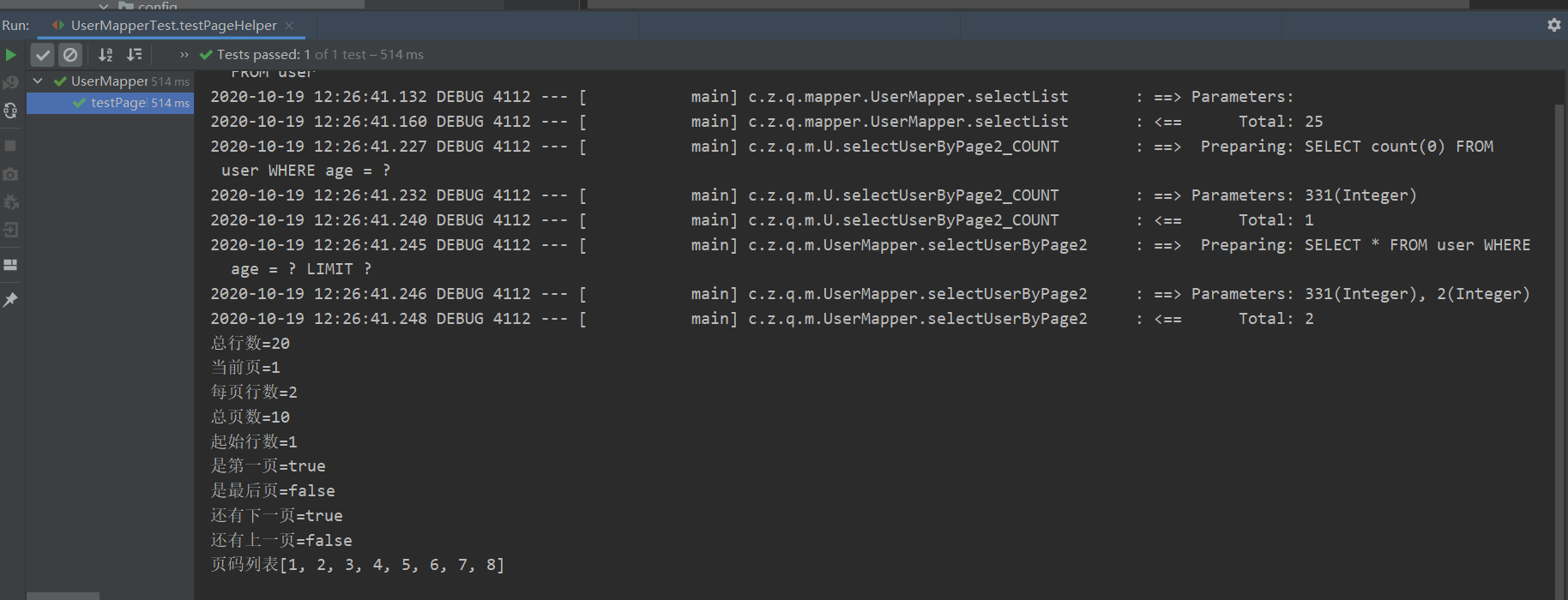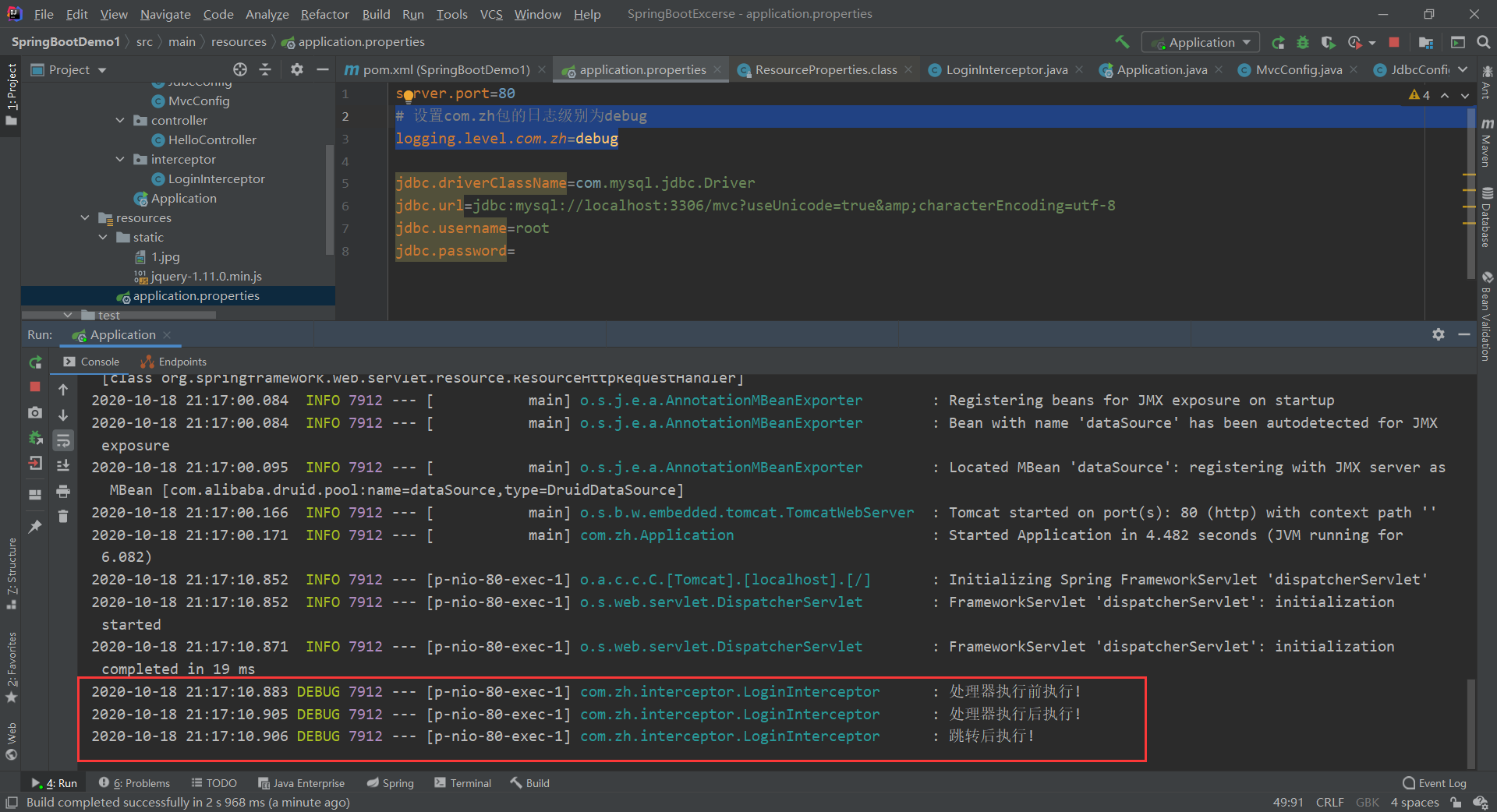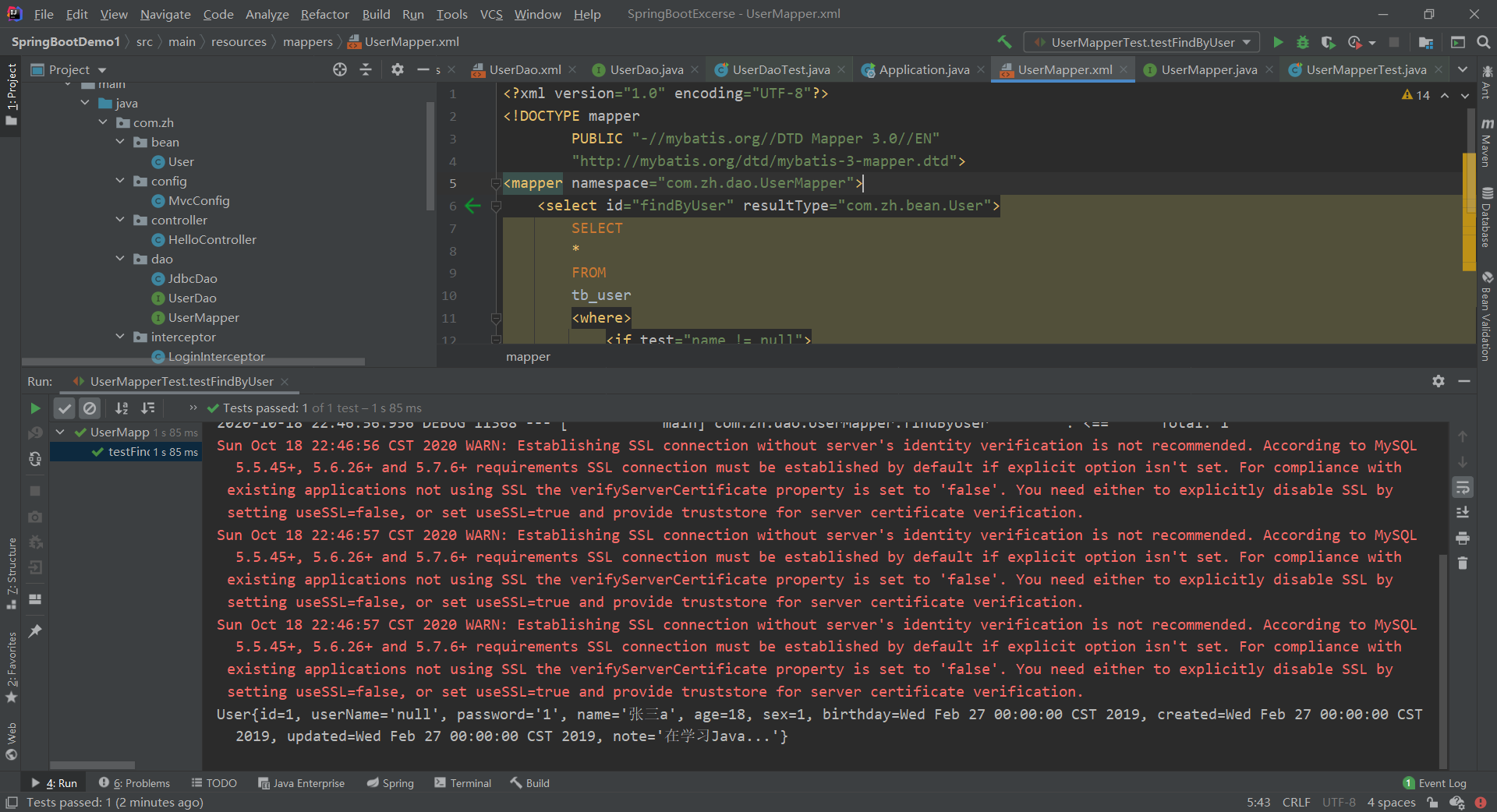1.整合SpringMVC
刚才案例已经能实现mvc自动配置,这里我们主要解决以下3个问题
- 修改端口
- 静态资源
-
修改端口
查看SpringBoot的全局属性可知,端口通过以下方式配置:
# 映射端口server.port=80
访问静态资源
ResourceProperties的类,里面就定义了静态资源的默认查找路径:

默认的静态资源路径为: classpath:/META-INF/resources/
- classpath:/resources/
- classpath:/static/
- classpath:/public
只要静态资源放在这些目录中任何一个,SpringMVC都会帮我们处理。
我们习惯会把静态资源放在 classpath:/static/ 目录下。我们创建目录,并且添加一些静态资源: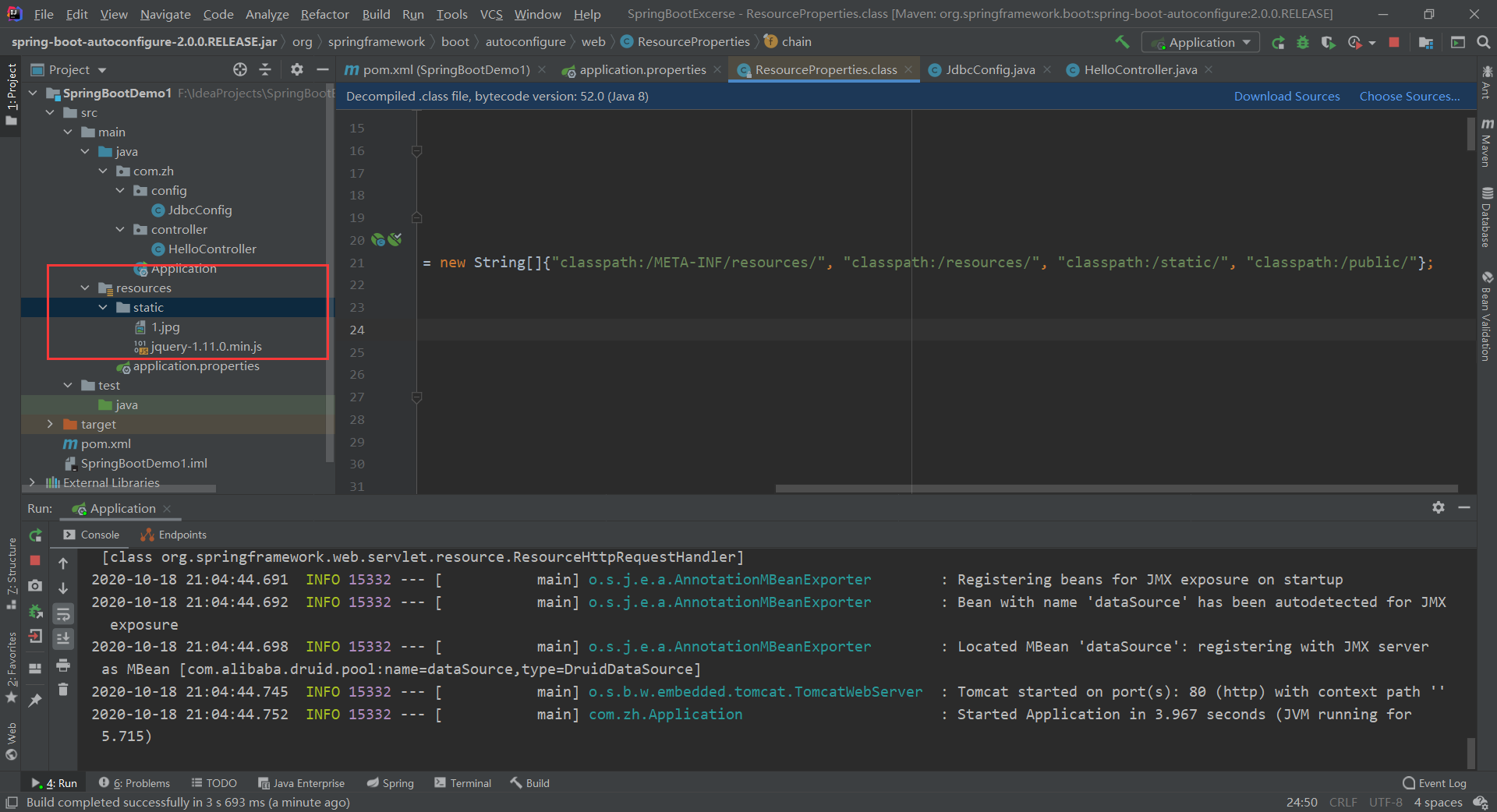
重启项目后测试: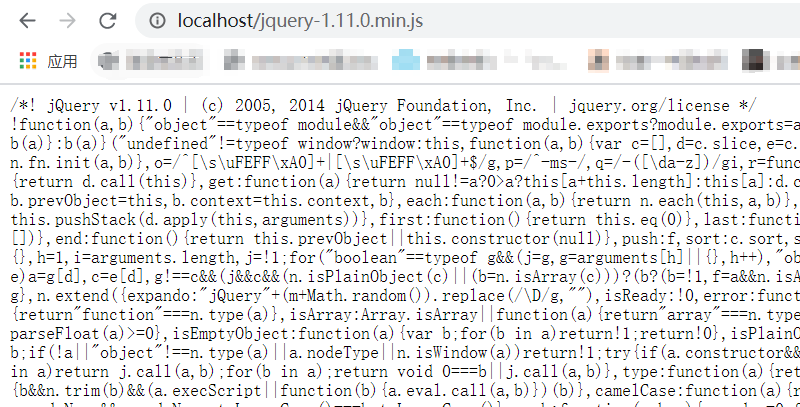

添加拦截器
拦截器也是我们经常需要使用的,在SpringBoot中该如何配置呢?
首先我们定义一个拦截器:
public class LoginInterceptor implements HandlerInterceptor {
private Logger logger = LoggerFactory.getLogger(LoginInterceptor.class);
@Override
public boolean preHandle(HttpServletRequest request, HttpServletResponse response, Object
handler) {
logger.debug("处理器执行前执行!");
return true;
}
@Override
public void postHandle(HttpServletRequest request, HttpServletResponse response, Object
handler, ModelAndView modelAndView) {
logger.debug("处理器执行后执行!");
}
@Override
public void afterCompletion(HttpServletRequest request, HttpServletResponse response, Object
handler, Exception ex) {
logger.debug("跳转后执行!");
}
}
通过实现 WebMvcConfigurer 并添加 @Configuration 注解来实现自定义部分SpringMvc配置:
@Configuration
public class MvcConfig implements WebMvcConfigurer {
/**
* 通过@Bean注解,将我们定义的拦截器注册到Spring容器
* @return
*/
@Bean
public LoginInterceptor loginInterceptor(){
return new LoginInterceptor();
}
/**
* 重写接口中的addInterceptors方法,添加自定义拦截器
* @param registry
*/
@Override
public void addInterceptors(InterceptorRegistry registry) {
// 通过registry来注册拦截器,通过addPathPatterns来添加拦截路径
registry.addInterceptor(this.loginInterceptor()).addPathPatterns("/**");
}
}
ant path路径匹配通配符
‘?’ 匹配任何单字符
‘’ 匹配0或者任意数量的字符
‘/*’ 匹配0或者更多的目录
结构如下: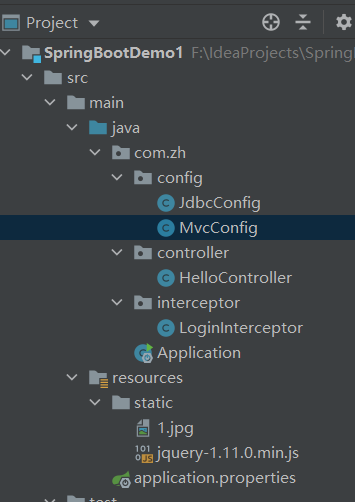
接下来运行并查看日志:
你会发现日志中什么都没有,因为我们记录的log级别是debug,默认是显示info以上,我们需要进行配置。
SpringBoot通过 logging.level.=debug 来配置日志级别,填写包名
# 设置com.zh包的日志级别为debug
logging.level.com.zh=debug
2.整合jdbc
导入资料中的t_user.sql文件
引入依赖
<dependency>
<groupId>org.springframework.boot</groupId>
<artifactId>spring-boot-starter-jdbc</artifactId>
</dependency>
<dependency>
<groupId>org.springframework.boot</groupId>
<artifactId>spring-boot-starter-test</artifactId>
</dependency>
当然,不要忘了数据库驱动,SpringBoot并不知道我们用的什么数据库,这里我们选择MySQL:
<dependency>
<groupId>mysql</groupId>
<artifactId>mysql-connector-java</artifactId>
<version>5.1.46</version>
</dependency>
配置连接池
其实,在刚才引入jdbc启动器的时候,SpringBoot已经自动帮我们引入了一个连接池: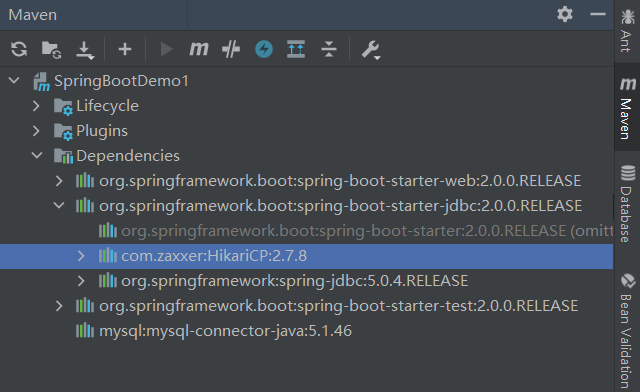
HikariCP应该是目前速度最快的连接池了,我们看看它与c3p0的对比: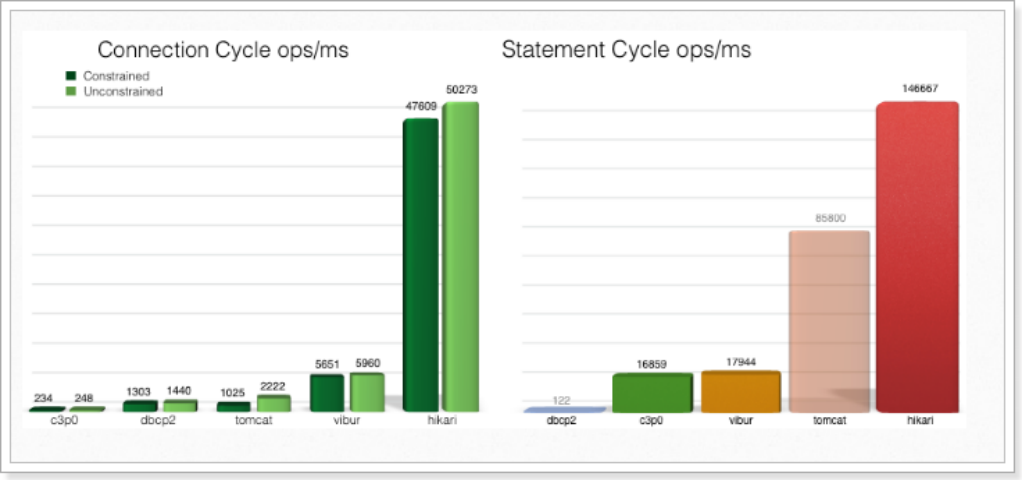
因此,我们只需要指定连接池参数即可:
# 连接四大参数
spring.datasource.url=jdbc:mysql://localhost:3306/springboot?useUnicode=true&characterEncoding=utf-8
spring.datasource.username=root
spring.datasource.password=
# 可省略,SpringBoot自动推断
spring.datasource.driverClassName=com.mysql.jdbc.Driver
spring.datasource.hikari.idle-timeout=60000
spring.datasource.hikari.maximum-pool-size=30
spring.datasource.hikari.minimum-idle=10
实体类
public class User implements Serializable {
private Long id;
// 用户名
//自动转换下换线到驼峰命名user_name -> userName
private String userName;
// 密码
private String password;
// 姓名
private String name;
// 年龄
private Integer age;
// 性别,1男性,2女性
private Integer sex;
// 出生日期
private Date birthday;
// 创建时间
private Date created;
// 更新时间
private Date updated;
// 备注
private String note;
public Long getId() {
return id;
}
public void setId(Long id) {
this.id = id;
}
public String getUserName() {
return userName;
}
public void setUserName(String userName) {
this.userName = userName;
}
public String getPassword() {
return password;
}
public void setPassword(String password) {
this.password = password;
}
public String getName() {
return name;
}
public void setName(String name) {
this.name = name;
}
public Integer getAge() {
return age;
}
public void setAge(Integer age) {
this.age = age;
}
public Integer getSex() {
return sex;
}
public void setSex(Integer sex) {
this.sex = sex;
}
public Date getBirthday() {
return birthday;
}
public void setBirthday(Date birthday) {
this.birthday = birthday;
}
public Date getCreated() {
return created;
}
public void setCreated(Date created) {
this.created = created;
}
public Date getUpdated() {
return updated;
}
public void setUpdated(Date updated) {
this.updated = updated;
}
public String getNote() {
return note;
}
public void setNote(String note) {
this.note = note;
}
@Override
public String toString() {
return "User{" +
"id=" + id +
", userName='" + userName + '\'' +
", password='" + password + '\'' +
", name='" + name + '\'' +
", age=" + age +
", sex=" + sex +
", birthday=" + birthday +
", created=" + created +
", updated=" + updated +
", note='" + note + '\'' +
'}';
}
}
dao
@Repository
public class JdbcDao {
@Autowired
private JdbcTemplate jdbcTemplate;
public List<User> findAll() {
return jdbcTemplate.query("select * from tb_user", new BeanPropertyRowMapper<>(User.class));
}
}
测试
@RunWith(SpringRunner.class)
@SpringBootTest
public class JdbcDaoTest {
@Autowired
private JdbcDao jdbcDao;
@Test
public void findAll() {
List<User> list = jdbcDao.findAll();
for (User user : list) {
System.out.println(user);
}
}
}
3.整合mybatis
mybatis
SpringBoot官方并没有提供Mybatis的启动器,不过Mybatis官网自己实现了:
<!--mybatis -->
<dependency>
<groupId>org.mybatis.spring.boot</groupId>
<artifactId>mybatis-spring-boot-starter</artifactId>
<version>1.3.2</version>
</dependency>
配置,基本没有需要配置的:
# mybatis 别名扫描
mybatis.type-aliases-package=com.zh.bean
# mapper.xml文件位置,如果没有映射文件,请注释掉
mybatis.mapper-locations=classpath:mappers/*.xml
实体类,直接使用jdbc用到的实体类,即上边的User
接口
public interface UserDao {
public List<User> findAll();
}
映射文件
<?xml version="1.0" encoding="UTF-8"?>
<!DOCTYPE mapper
PUBLIC "-//mybatis.org//DTD Mapper 3.0//EN"
"http://mybatis.org/dtd/mybatis-3-mapper.dtd">
<mapper namespace="com.zh.dao.UserDao">
<select id="findAll" resultType="user">
select * from tb_user
</select>
</mapper>
Mapper的加载接口代理对象方式有2种
第一种:使用@Mapper注解(不推荐)
需要注意,这里没有配置mapper接口扫描包,因此我们需要给每一个Mapper接口添加 @Mapper 注解,才能被识
别。
@Mapper
public interface UserMapper {
}
第二种设置MapperScan,注解扫描的包(推荐)
@MapperScan(“dao所在的包”),自动搜索包中的接口,产生dao的代理对象
@SpringBootApplication
@MapperScan("com.zh.dao")
public class Application {
public static void main(String[] args) {
SpringApplication.run(Application.class, args);
}
}
测试
引入测试构建
<dependency>
<groupId>org.springframework.boot</groupId>
<artifactId>spring-boot-starter-test</artifactId>
</dependency>
测试代码
@RunWith(SpringRunner.class)
@SpringBootTest
public class UserDaoTest {
@Autowired
private UserDao userDao;
@Test
public void testFindAll() {
userDao.findAll().forEach(System.out::println);
}
}
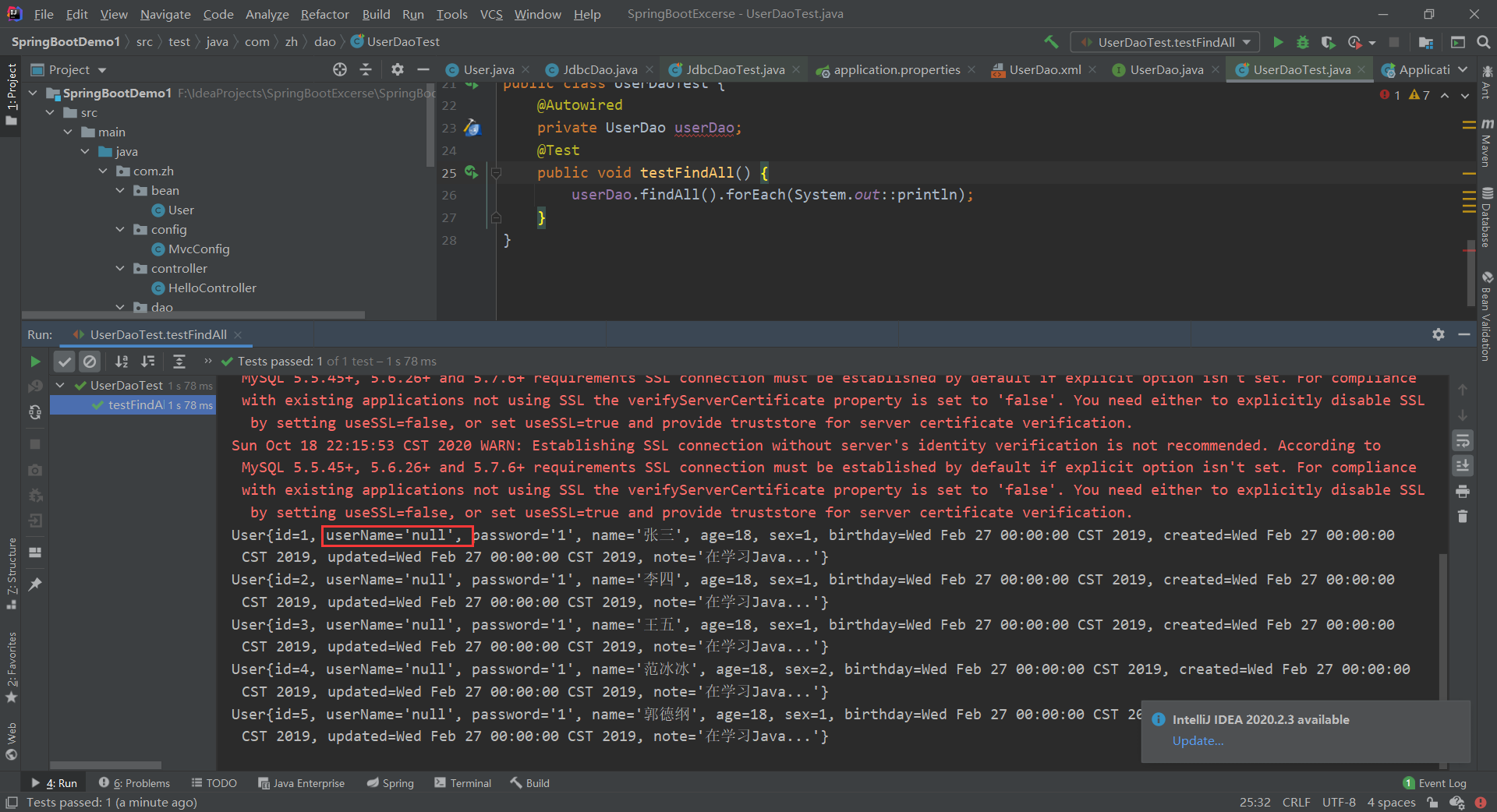
可以看到,这里是username没有值的,所以这个是不会自己转换的
通用mapper
概念
使用Mybatis时,最大的问题是,要写大量的重复SQL语句在xml文件中,除了特殊的业务逻辑SQL语句之外,还有大量结构类似的增删改查SQL。而且,当数据库表结构改动时,对应的所有SQL以及实体类都需要更改。这大量增加了程序员的负担。避免重复书写CRUD映射的框架有两个:
- 通用mybatis(tk mybatis)
- mybatis plus,通能更加强大,后面实战项目中讲解
通用Mapper的作者也为自己的插件编写了启动器,我们直接引入即可:
<!-- 通用mapper -->
<dependency>
<groupId>tk.mybatis</groupId>
<artifactId>mapper-spring-boot-starter</artifactId>
<version>2.0.2</version>
</dependency>
实体类
tk mybatis 实体类使用的注解是jpa注解
@Table(name = "tb_user")
public class User implements Serializable {
@Id
@GeneratedValue(strategy = GenerationType.IDENTITY)
private Long id;
// 用户名
private String userName;
....
注意事项:
1. 默认表名=类名,字段名=属性名
2. 表名可以使用 @Table(name = “tableName”) 进行指定
3. @Column(name = “fieldName”) 指定
4. 使用 @Transient 注解表示跟字段不进行映射
不需要做任何配置就可以使用了。
@Mapper
public interface UserMapper extends tk.mybatis.mapper.common.Mapper<User>{
public List<User> findByUser(User user);
}
自定义映射文件
映射复杂方法 resources/mappers/UserMapper.xml
<?xml version="1.0" encoding="UTF-8"?>
<!DOCTYPE mapper
PUBLIC "-//mybatis.org//DTD Mapper 3.0//EN"
"http://mybatis.org/dtd/mybatis-3-mapper.dtd">
<mapper namespace="com.zh.dao.UserMapper">
<select id="findByUser" resultType="user">
SELECT
*
FROM
tb_user
<where>
<if test="name != null">
name like '%${name}%'
</if>
<if test="note != null">
and note like '%${note}%'
</if>
</where>
</select>
</mapper>
一旦继承了Mapper,继承的Mapper就拥有了Mapper所有的通用方法:
Select 方法: List
方法: T selectByPrimaryKey(Object key); 说明:根据主键字段进行查询,方法参数必须包含完整的主键属性,查询条件使用等号
方法: List
方法: T selectOne(T record); 说明:根据实体中的属性进行查询,只能有一个返回值,有多个结果是抛出异常,查询条件使用等号
方法: int selectCount(T record); 说明:根据实体中的属性查询总数,查询条件使用等号
Insert 方法: int insert(T record); 说明:保存一个实体,null的属性也会保存,不会使用数据库默认值
方法: int insertSelective(T record); 说明:保存一个实体,null的属性不会保存,会使用数据库默认值
Update 方法: int updateByPrimaryKey(T record); 说明:根据主键更新实体全部字段,null值会被更新
方法: int updateByPrimaryKeySelective(T record); 说明:根据主键更新属性不为null的值
Delete 方法: int delete(T record); 说明:根据实体属性作为条件进行删除,查询条件使用等号
方法: int deleteByPrimaryKey(Object key); 说明:根据主键字段进行删除,方法参数必须包含完整的主键属性
Example方法
方法: List
方法: int selectCountByExample(Object example); 说明:根据Example条件进行查询总数
方法: int updateByExample(@Param(“record”) T record, @Param(“example”) Object example); 说明:根据Example条件更新实体 record 包含的全部属性,null值会被更新
方法: int updateByExampleSelective(@Param(“record”) T record, @Param(“example”) Object example); 说明:根据Example条件更新实体 record 包含的不是null的属性值
方法: int deleteByExample(Object example); 说明:根据Example条件删除数据
注意要把MapperScan类改成tk-mybatis构件的类
import tk.mybatis.spring.annotation.MapperScan;
@SpringBootApplication
@EnableConfigurationProperties
@MapperScan("com.zh.dao")
public class Application {
public static void main(String[] args) {
SpringApplication.run(Application.class, args);
}
}
注意:必须使用tk mybatis的MapperScan
**
启动测试
测试类
@RunWith(SpringRunner.class)
@SpringBootTest
public class UserMapperTest extends TestCase {
@Autowired
private UserMapper userMapper;
@Test
public void testFindByUser() {
User condition = new User();
condition.setName("a");
List<User> list = userMapper.findByUser(condition);
for (User user : list) {
System.out.println(user);
}
}
@Test
public void testFindAll() {
List<User> list = userMapper.selectAll();
for (User user : list) {
System.out.println(user);
}
}
@Test
public void testFindById() {
User user = userMapper.selectByPrimaryKey(4);
System.out.println(user);
}
@Test
public void testFindByExample() {
Example example = new Example(User.class);
example.createCriteria().andLike("name", "%a%");
userMapper.selectByExample(example).forEach(System.out::println);
}
@Test
public void testInsert() {
User user = new User();
user.setAge(18);
user.setBirthday(new Date());
user.setCreated(new Date());
user.setName("周星驰");
userMapper.insert(user);
}
}
4.Thymeleaf
概念
Thymeleaf 是一个跟 FreeMarker 类似的模板引擎,它可以完全替代 JSP 。相较与其他的模板引擎,它有如下特点:
- 动静结合:Thymeleaf 在有网络和无网络的环境下皆可运行,无网络显示静态内容,有网络用后台得到数据替换静态内容
- 与SpringBoot完美整合,springboot默认整合thymeleaf
4.1 入门案例
编写接口
编写UserService,调用UserMapper的查询所有方法
@Service
public class UserService {
@Autowired
private UserMapper userMapper;
public List<User> findAll() {
return this.userMapper.selectAll();
}
}
编写一个controller,返回一些用户数据,放入模型中,等会在页面渲染 编写一个controller,返回一些用户数据,放入模型中,等会在页面渲染
@Controller
public class UserController {
@Autowired
private UserService userService;
@RequestMapping("/all")
public String all(Model model) {
List<User> list = userService.findAll();
model.addAttribute("users", list);
// 返回模板名称(就是classpath:/templates/目录下的html文件名)
return "users";
}
}
引入启动器
直接引入启动器:
<dependency>
<groupId>org.springframework.boot</groupId>
<artifactId>spring-boot-starter-thymeleaf</artifactId>
</dependency>
SpringBoot会自动为Thymeleaf注册一个视图解析器:
与解析JSP的InternalViewResolver类似,Thymeleaf也会根据前缀和后缀来确定模板文件的位置:
默认前缀: classpath:/templates/
默认后缀: .html
所以如果我们返回视图: users ,会指向到 classpath:/templates/users.html
一般我们无需进行修改,默认即可。
静态页面
根据上面的文档介绍,模板默认放在classpath下的templates文件夹,我们新建一个html文件放入其中: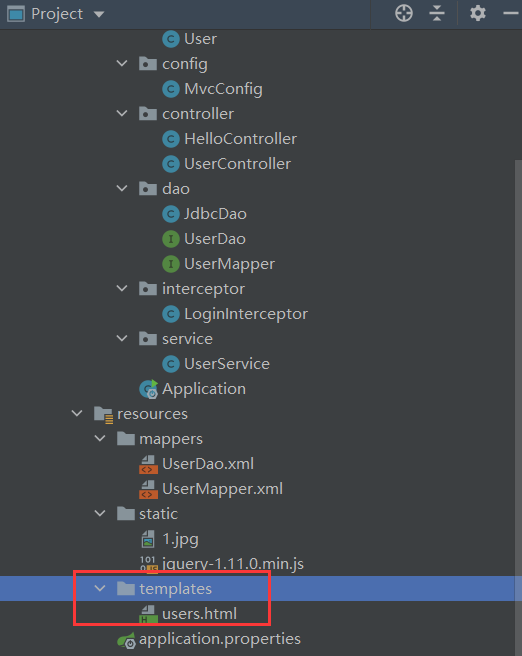
编写html模板,渲染模型中的数据:
注意,把html 的名称空间,改成: xmlns:th=”http://www.thymeleaf.org“ 会有语法提示
<!DOCTYPE html>
<html xmlns:th="http://www.thymeleaf.org">
<head>
<meta charset="UTF-8">
<title>首页</title>
<style type="text/css">
table {border-collapse: collapse; font-size: 14px; width: 80%; margin: auto}
table, th, td {border: 1px solid darkslategray;padding: 10px}
</style>
</head>
<body>
<div style="text-align: center">
<span style="color: darkslategray; font-size: 30px">欢迎光临!</span>
<hr/>
<table class="list">
<tr>
<th>id</th>
<th>姓名</th>
<th>用户名</th>
<th>年龄</th>
<th>性别</th>
<th>生日</th>
<th>备注</th>
<th>操作</th>
</tr>
<tr th:each="user, status : ${users}" th:object="${user}">
<td th:text="${user.id}">1</td>
<td th:text="*{name}">张三</td>
<td th:text="*{userName}">zhangsan</td>
<td th:text="${user.age}">20</td>
<td th:text="${user.sex} == 1 ? '男': '女'">男</td>
<td th:text="${#dates.format(user.birthday, 'yyyy-MM-dd')}">1980-02-30</td>
<td th:text="${user.note}">1</td>
<td>
<a th:href="@{/delete(id=${user.id}, userName=*{userName})}">删除</a>
<a th:href="|/update/${user.id}|">修改</a>
<a th:href="'/approve/' + ${user.id}">审核</a>
</td>
</tr>
</table>
</div>
</body>
</html>
我们看到这里使用了以下语法:
- ${} :这个类似与el表达式,但其实是ognl的语法,比el表达式更加强大
- th- 指令: th- 是利用了Html5中的自定义属性来实现的。如果不支持H5,可以用 data-th- 来代替
- th:each :类似于 c:foreach 遍历集合,但是语法更加简洁
- th:text :声明标签中的文本
- 例如 1 ,如果user.id有值,会覆盖默认的1
- 如果没有值,则会显示td中默认的1。这正是thymeleaf能够动静结合的原因,模板解析失败不影响页面的显示效果,因为会显示默认值!
测试
接下来,我们打开页面测试一下:
模板缓存
Thymeleaf会在第一次对模板解析之后进行缓存,极大的提高了并发处理能力。但是这给我们开发带来了不便,修改页面后并不会立刻看到效果,我们开发阶段可以关掉缓存使用:
# 开发阶段关闭thymeleaf的模板缓存
spring.thymeleaf.cache=false
注意:
在Idea中,我们需要在修改页面后按快捷键: Ctrl + Shift + F9 对项目进行rebuild才可以。
我们可以修改页面,测试一下。
4.2 thymeleaf详解
表达式
它们分为三类
- 变量表达式
- 选择或星号表达式
- URL表达式
变量表达式
变量表达式即OGNL表达式或Spring EL表达式(在Spring中用来获取model attribute的数据)。如下所示:
${session.user.name}
它们将以HTML标签的一个属性来表示:
<h5>表达式</h5>
<span>${text}</span>
<span th:text="${text}">你好 thymleaf</span>
选择(星号)表达式
选择表达式很像变量表达式,不过它们用一个预先选择的对象来代替上下文变量容器(map)来执行,如下:
*{customer.name}
被指定的object由th:object属性定义:
users.html
<tr th:each="user : ${users}" th:object="${user}">
<td th:text="${user.id}">1</td>
<td th:text="*{name}">张三</td>
<td th:text="*{userName}">zhangsan</td>
....
URL表达式
URL表达式指的是把一个有用的上下文或回话信息添加到URL,这个过程经常被叫做URL重写。
@{/order/list}
URL还可以设置参数:
@{/order/details(id=${orderId}, name=*{name})}
相对路径:
@{../documents/report}
让我们看这些表达式:
注意要写在 th: 下才可以解析
<form th:action="@{/createOrder}">
<a href="main.html" th:href="@{/main}">
url表达式
<a th:href="@{/delete(id=${user.id}, userName=*{userName})}">删除</a>
文本替换
<a th:href="|/update/${user.id}|">修改</a>
字符串拼接
<a th:href="'/approve/' + ${user.id}">审核</a>
表达式常见用法
字面(Literals)
- 文本文字(Text literals): ‘one text’, ‘Another one!’,…
- 数字文本(Number literals): 0, 34, 3.0, 12.3,…
- 布尔文本(Boolean literals): true, false
- 空(Null literal): null
文字标记(Literal tokens): one, sometext, main,…
文本操作(Text operations)
字符串连接(String concatenation): +
文本替换(Literal substitutions): |The name is ${name}|
算术运算(Arithmetic operations)
二元运算符(Binary operators): +, -, *, /, %
减号(单目运算符)Minus sign (unary operator): -
布尔操作(Boolean operations)
二元运算符(Binary operators): and, or
布尔否定(一元运算符)Boolean negation (unary operator): !, not
比较和等价(Comparisons and equality)
比较(Comparators): >, <, >=, <= (gt, lt, ge, le)
等值运算符(Equality operators): ==, != (eq, ne)
条件运算符(Conditional operators)
If-then: (if) ? (then)
- If-then-else: (if) ? (then) : (else)
- Default: (value) ?: (defaultvalue)
常用th标签
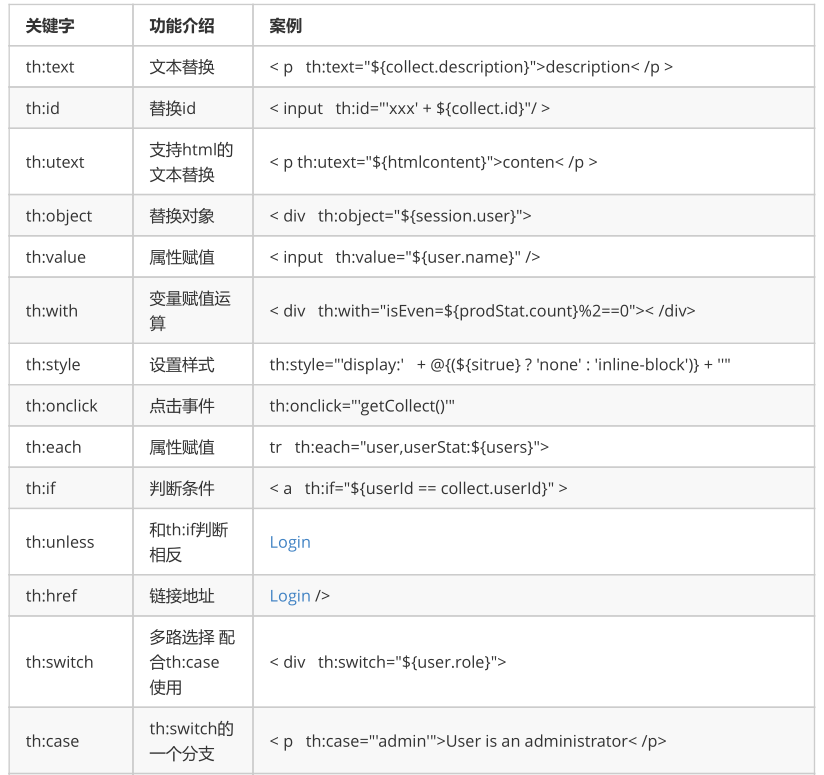
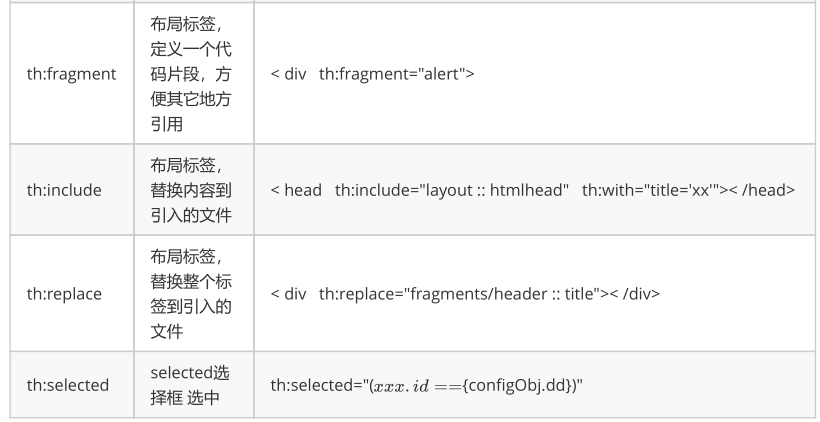
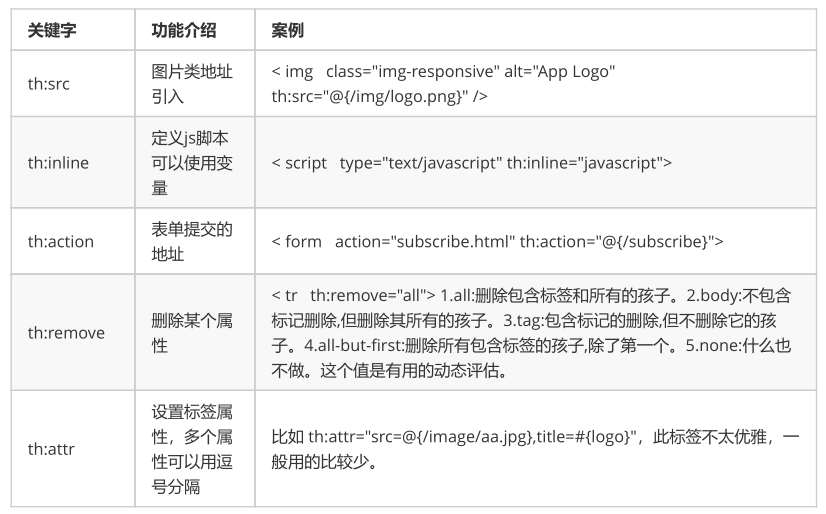
还有非常多的标签,这里只列出最常用的几个基本用法
- 赋值、字符串拼接
字符串拼接还有另外一种简洁的写法<a th:href="|/update/${user.id}|">修改</a> <a th:href="'/approve/' + ${user.id}">审核</a> 条件判断 If/Unless
Thymeleaf中使用th:if和th:unless属性进行条件判断,下面的例子中, 标签只有在 th:if 中条件成立时才显示:<h5>if指令</h5> <a th:if="${users.size() > 0}">查询结果存在</a><br> <a th:if="${users.size() <= 0}">查询结果不存在</a><br> <a th:unless="${session.user != null}" href="#">登录</a><br>th:unless与th:if恰好相反,只有表达式中的条件不成立,才会显示其内容。
也可以使用 (if) ? (then) : (else) 这种语法来判断显示的内容-
<tr th:each="user, status : ${users}" th:object="${user}" th:class="${status.even} ?'grey':'blue'"> <td th:text="${status.even}"></td> <td th:text="${user.id}">1</td> <td th:text="*{name}">张三</td> <td th:text="*{userName}">zhangsan</td> <td th:text="${user.age}">20</td> <td th:text="${user.sex} == 1 ? '男' : '女'">男</td> <td th:text="${#dates.format(user.birthday, 'yyyy-MM-dd')}">1980-02-30</td> <td th:text="${user.note}">1</td> <td> <a th:href="@{/delete(id=${user.id}, userName=*{userName})}">删除</a> <a th:href="|/update/${user.id}|">修改</a> <a th:href="'/approve/' + ${user.id}">审核</a> </td> </tr>status称作状态变量,属性有:
- index:当前迭代对象的index(从0开始计算)
- count: 当前迭代对象的index(从1开始计算)
- size:被迭代对象的大小
- current:当前迭代变量
- even/odd:布尔值,当前循环是否是偶数/奇数(从0开始计算)
- first:布尔值,当前循环是否是第一个
- last:布尔值,当前循环是否是最后一个

4. 内联文本
内联文本:[[…]]内联文本的表示方式,使用时,必须先用th:inline=”text/javascript/none”激活,th:inline可以在父级标签内使用,甚至作为body的标签。内联文本尽管比th:text的代码少,不利于原型显示。
在thymeleaf指令中显示
<h6 th:text="${text}">静态内容</h6>
使用内联文本显示model attribute
<h5>内联文本</h5>
<div>
<h6 th:inline="text">[[${text}]]</h6>
<h6 th:inline="none">[[${text}]]</h6>
<h6>[[${text}]]</h6>
</div>
原则能用指令就用th指令
- 内联js
内联文本:[[…]]内联文本的表示方式,使用时,必须先用th:inline=”text/javascript/none”激活,th:inline可以在父级标签内使用,甚至作为body的标签。内联文本尽管比th:text的代码少,不利于原型显示。<h5>内联js</h5> <script th:inline="javascript"> /*<![CDATA[*/ var text = '[[${text}]]'; alert(text); /*]]>*/ </script> - 内嵌变量
为了模板更加易用,Thymeleaf还提供了一系列Utility对象(内置于Context中),可以通过#直接访问:
- dates : java.util.Date**的功能方法类。
- calendars : 类似#dates,面向java.util.Calendar
- numbers : 格式化数字的功能方法类
- strings : 字符串对象的功能类,contains,startWiths,prepending/appending等等。
- objects: 对objects的功能类操作。
- bools: 对布尔值求值的功能方法。
- arrays:对数组的功能类方法。
- lists: 对lists功能类方法
- sets
- maps
…
下面用一段代码来举例一些常用的方法:
dates
<h5>内置变量</h5>
<h6 th:text="${#dates.createNow()}">获取当前日期</h6>
strings
<h5>内置变量</h5>
<h6 th:text="${#dates.createNow()}">获取当前日期</h6>
<h6 th:text="${#strings.substring(text, 6, 9)}">截取字符串</h6>
<h6 th:text="${#strings.length(text)}">获得长度</h6>
<h6 th:text="${#strings.randomAlphanumeric(6)}">随机字符串</h6>
<h6 th:text="${#strings.equals(text, 'hello text....')}"></h6>
使用thymeleaf布局
使用thymeleaf布局非常的方便
在/resources/templates/目录下创建footer.html,内容如下
<!DOCTYPE html>
<html xmlns:th="http://www.thymeleaf.org">
<body>
<footer th:fragment="copy(title)">
© 2020 ZH版权所有<br>
<span th:text="${title}">title footer</span>
</footer>
</body>
</html>
在页面任何地方引入:
<h5>thymeleaf布局</h5>
<div th:insert="footer :: copy('哈哈')"></div>
<div th:replace="footer :: copy('嘿嘿')"></div>
<div th:include="footer :: copy('呀呀')"></div>
- th:insert :保留自己的主标签,保留th:fragment的主标签。
- th:replace :不要自己的主标签,保留th:fragment的主标签。
- th:include :保留自己的主标签,不要th:fragment的主标签。(官方3.0后不推荐)
返回的HTML如下: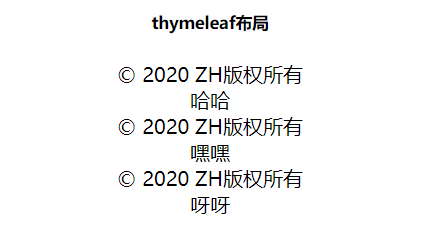
<h5>thymeleaf布局</h5>
<div><footer>
© 2020 ZH版权所有<br>
<span>哈哈</span>
</footer></div>
<footer>
© 2020 ZH版权所有<br>
<span>嘿嘿</span>
</footer>
<div>
© 2020 ZH版权所有<br>
<span>呀呀</span>
</div>
5. Mybatis Plus
简介

Mybatis-Plus(简称MP)是一个 Mybatis 的增强工具,在 Mybatis 的基础上只做增强不做改变,避免了我们重复CRUD语句。
快速入门
创建工程,引入依赖
<?xml version="1.0" encoding="UTF-8"?>
<project xmlns="http://maven.apache.org/POM/4.0.0"
xmlns:xsi="http://www.w3.org/2001/XMLSchema-instance"
xsi:schemaLocation="http://maven.apache.org/POM/4.0.0 http://maven.apache.org/xsd/maven-4.0.0.xsd">
<modelVersion>4.0.0</modelVersion>
<groupId>com.zh</groupId>
<artifactId>mybatis-plus-demo-quickstart</artifactId>
<version>1.0-SNAPSHOT</version>
<parent>
<groupId>org.springframework.boot</groupId>
<artifactId>spring-boot-starter-parent</artifactId>
<version>2.3.0.RELEASE</version>
<relativePath/>
</parent>
<properties>
<project.build.sourceEncoding>UTF-8</project.build.sourceEncoding>
<project.reporting.outputEncoding>UTF-8</project.reporting.outputEncoding>
<java.version>1.8</java.version>
<mybatisplus.version>3.3.2</mybatisplus.version>
<skipTests>true</skipTests>
</properties>
<dependencies>
<dependency>
<groupId>org.springframework.boot</groupId>
<artifactId>spring-boot-starter</artifactId>
</dependency>
<dependency>
<groupId>com.h2database</groupId>
<artifactId>h2</artifactId>
<scope>runtime</scope>
</dependency>
<dependency>
<groupId>com.baomidou</groupId>
<artifactId>mybatis-plus-boot-starter</artifactId>
<version>${mybatisplus.version}</version>
</dependency>
<dependency>
<groupId>org.assertj</groupId>
<artifactId>assertj-core</artifactId>
<scope>test</scope>
</dependency>
<dependency>
<groupId>org.projectlombok</groupId>
<artifactId>lombok</artifactId>
<scope>provided</scope>
</dependency>
<dependency>
<groupId>org.springframework.boot</groupId>
<artifactId>spring-boot-starter-test</artifactId>
<scope>test</scope>
</dependency>
</dependencies>
<build>
<plugins>
<plugin>
<groupId>org.springframework.boot</groupId>
<artifactId>spring-boot-maven-plugin</artifactId>
</plugin>
</plugins>
</build>
</project>
配置文件application.yml
yml配置简介
在Springboot中,推荐使用properties或者YAML文件来完成配置,但是对于较复杂的数据结构来说,YAML又远远优于properties。我们快速介绍YAML的常见语法格式。
先来看一个Springboot中的properties文件和对应YAML文件的对比:
#properties(示例来源于Springboot User guide):
environments.dev.url=http://dev.bar.com
environments.dev.name=Developer Setup
environments.prod.url=http://foo.bar.com
environments.prod.name=My Cool App
my.servers[0]=dev.bar.com
my.servers[1]=foo.bar.com
可以明显的看到,在处理层级关系的时候,properties需要使用大量的路径来描述层级(或者属性),比如
environments.dev.url和environments.dev.name。其次,对于较为复杂的结构,比如数组(my.servers),写起
来更为复杂。而对应的YAML格式文件就简单很多:
#YAML格式
environments:
dev:
url: http://dev.bar.com
name: Developer Setup
prod:
url: http://foo.bar.com
name: My Cool App
my:
servers:
- dev.bar.com
- foo.bar.com
我们可以使用插件来快速生成: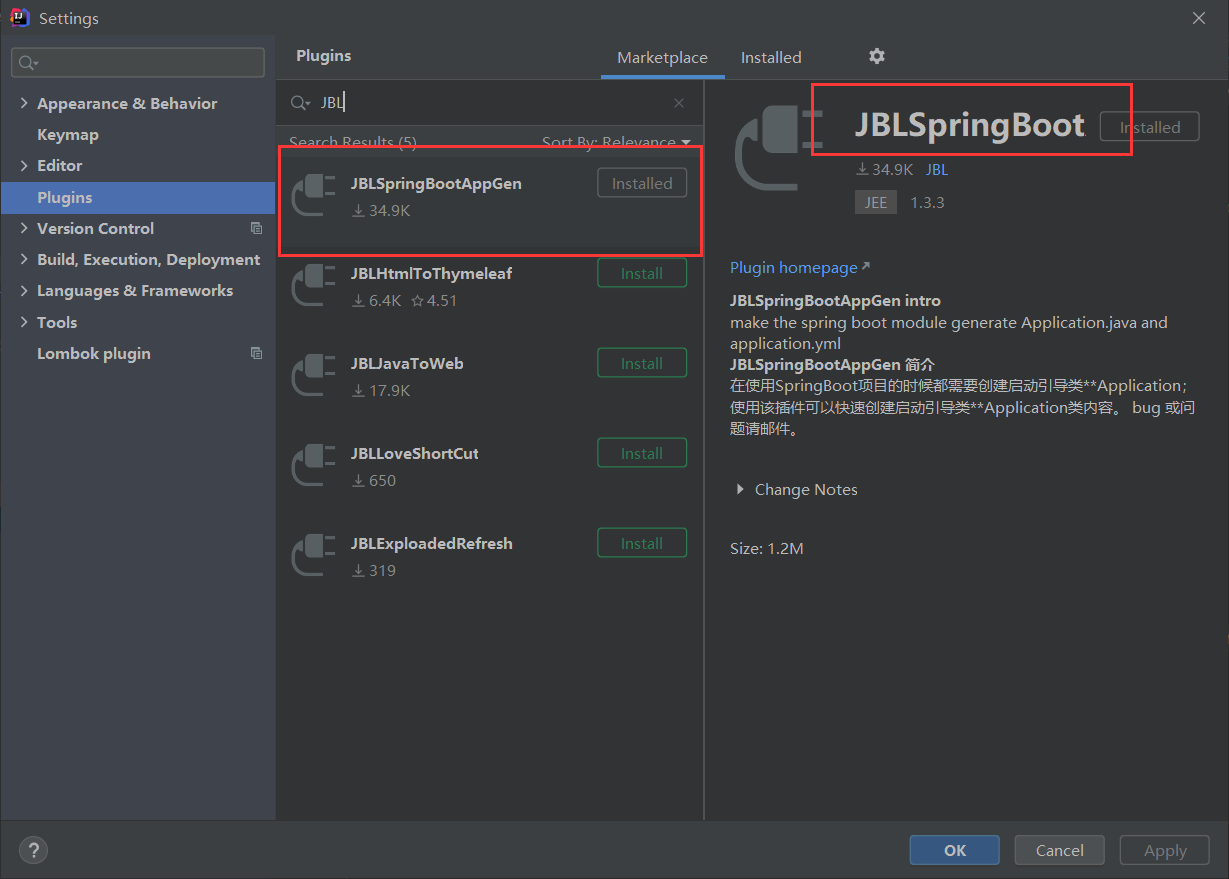


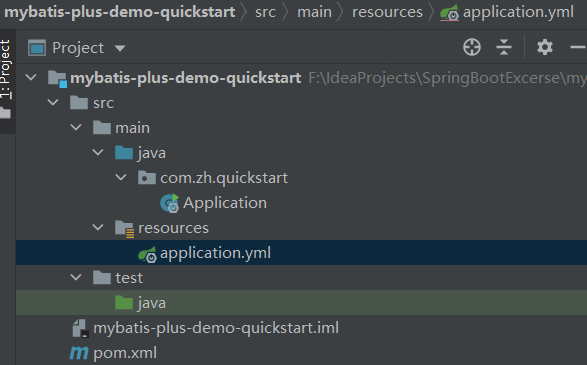
application.yml
# DataSource Config
spring:
datasource:
driver-class-name: org.h2.Driver
schema: classpath:db/schema-h2.sql
data: classpath:db/data-h2.sql
url: jdbc:h2:mem:test
username: root
password: test
# Logger Config
logging:
level:
com.zh.quickstart: debug
数据库脚本文件/db/data-h2.sql和/db/schema-h2.sql(拷贝)
h2数据库是一个基于内存的数据库,在jvm启动时,自动执行脚本加载相应的数据
springboot 中使用h2数据库直接按照上面配置,配置schema表结构脚本和data数据脚本即可
注意这里用户名密码可以省略不写,或者随意设定
启动类
@SpringBootApplication
@MapperScan("com.zh.quickstart.mapper")
public class Application {
public static void main(String[] args) {
SpringApplication.run(Application.class, args);
}
}
实体类
@Data
public class User {
private Long id;
private String name;
private Integer age;
private String email;
}
dao
public interface UserMapper extends BaseMapper<User> {
}
测试
@RunWith(SpringRunner.class)
@SpringBootTest
public class UserMapperTest extends TestCase {
@Resource
private UserMapper userMapper;
@Test
public void testSelect() {
System.out.println(("----- selectAll method test ------"));
List<User> userList = userMapper.selectList(null);
Assert.assertEquals(5, userList.size());
userList.forEach(System.out::println);
}
}
常用注解
MyBatisPlus提供了一些注解供我们在实体类和表信息出现不对应的时候使用。通过使用注解完成逻辑上匹配。

mybatis plus注解策略配置
如果mysql自增主键注解策略设置如下
@TableId(type = IdType.AUTO)
private Long id;
默认主键策略
/**
* 采用雪花算法生成全局唯一主键
**/
ASSIGN_ID(3),
排除实体类中非表字段
使用 @TableField(exist = false) 注解
主键策略参考源码IdType
内置增删改查
测试
@Test
public void testInsert() {
User user = new User();
user.setName("masan");
user.setEmail("mansan@163.com");
user.setAge(3);
Assert.assertTrue(mapper.insert(user) > 0);
mapper.selectList(null).forEach(System.out::println);
}
@Test
public void testDelete() {
// //主键删除
// mapper.deleteById(3l);
// mapper.selectList(null).forEach(System.out :: println);
// //批量删除:1
// mapper.delete(new QueryWrapper<User>().like("name", "J"));
// mapper.selectList(null).forEach(System.out :: println);
// //批量删除:2
// mapper.delete(Wrappers.<User>query().like("name", "J"));
// mapper.selectList(null).forEach(System.out :: println);
//批量删除:2
mapper.delete(Wrappers.<User>query().lambda().like(User::getName, "J"));
mapper.selectList(null).forEach(System.out::println);
}
@Test
public void testUpdate() {
// //基本修改
// mapper.updateById(new User().setId(1l).setName("慧科"));
// mapper.selectList(null).forEach(System.out :: println);
// //批量修改:1
// mapper.update(null, Wrappers.<User>update().set("email", "huike@163.com").like("name","J"));
// mapper.selectList(null).forEach(System.out :: println);
//批量修改:2
mapper.update(new User().setEmail("huike@163.com"), Wrappers.<User>update().like("name", "J"));
mapper.selectList(null).forEach(System.out::println);
}
@Test
public void testSelect() {
// //基本查询
// System.out.println(mapper.selectOne(Wrappers.<User>query().eq("name", "Tom")));
//投影查询
mapper.selectList(new QueryWrapper<User>().select("id", "name")).forEach(user -> {
System.out.println(user);
});
}
分页
内置分页
@Configuration
public class MybatisPlusConfig {
/**
* 分页插件
*/
@Bean
public PaginationInterceptor paginationInterceptor() {
// 开启 count 的 join 优化,只针对 left join !!!
return new PaginationInterceptor().setCountSqlParser(new JsqlParserCountOptimize(true));
}
}
优化left join count场景
在一对一join操作时,也存在优化可能,看下面sql
select u.id,ua.account from user u left join user_account ua on u.id=ua.uid
#本来生成的count语句像这样
select count(1) from (select u.id,ua.account from user u left join user_account ua on u.id=ua.uid)
这时候分页查count时,其实可以去掉left join直查user,因为user与user_account是1对1关系,如下:
查count:
select count(1) from user u
查记录:
select u.id,ua.account from user u left join user_account ua on u.id=ua.uid limit 0,50
测试
@Test
public void testPage() {
System.out.println("------ baseMapper 自带分页 ------");
Page<User> page = new Page<>(1, 5);
IPage<User> pageResult = mapper.selectPage(page, new QueryWrapper<User>().eq("age", 20));
System.out.println("总条数 ------> " + pageResult.getTotal());
System.out.println("当前页数 ------> " + pageResult.getCurrent());
System.out.println("当前每页显示数 ------> " + pageResult.getSize());
pageResult.getRecords().forEach(System.out :: println);
}
自定义xml分页
application.yml配置文件
# 配置mybatis plus
mybatis-plus:
type-aliases-package: com.zh.quickstart.bean #别名搜索
mapper-locations: classpath:/mapper/*.xml #加载映射文件
UserMapper接口
public interface UserMapper extends BaseMapper<User> {
/**
* 如果映射的接口方法有2个参数需要@Param定义参数名,定义参数名后,映射文件中使用p.属性 c.属性,具体访问
*
* @param page
* @param condition
* @return
*/
IPage<User> selectUsersByPage(@Param("p") IPage<User> page, @Param("c") User condition);
}
UserMapper.xml映射文件
<?xml version="1.0" encoding="UTF-8"?>
<!DOCTYPE mapper
PUBLIC "-//mybatis.org//DTD Mapper 3.0//EN"
"http://mybatis.org/dtd/mybatis-3-mapper.dtd">
<mapper namespace="com.zh.quickstart.mapper.UserMapper">
<sql id="selectSql">
SELECT
*
FROM
user
</sql>
<select id="selectUsersByPage" resultType="com.zh.quickstart.bean.User">
<include refid="selectSql"></include>
<where>
<if test="c.age !=null">
age = #{c.age}
</if>
<if test="c.email !=null">
and email like '%${c.email}%'
</if>
</where>
</select>
</mapper>
测试
@Test
public void testXmlPage() {
System.out.println("------ baseMapper 自定义xml分页 ------");
Page<User> page = new Page<>(1, 5);
User user = new User();
user.setAge(331);
user.setEmail("test4");
IPage<User> pr = mapper.selectUsersByPage(page, user);
System.out.println("总条数 ------> " + pr.getTotal());
System.out.println("当前页数 ------> " + pr.getCurrent());
System.out.println("当前每页显示数 ------> " + pr.getSize());
pr.getRecords().forEach(System.out :: println);
}
pageHelper分页
引入pageHelper依赖
<dependency>
<groupId>com.github.pagehelper</groupId>
<artifactId>pagehelper</artifactId>
<version>5.1.11</version>
</dependency>
mybatis plus 整合pageHelper的配置类
@Configuration
public class MybatisPlusConfig {
/**
* 分页插件
*/
@Bean
public PaginationInterceptor paginationInterceptor() {
// 开启 count 的 join 优化,只针对 left join !!!
return new PaginationInterceptor().setCountSqlParser(new JsqlParserCountOptimize(true));
}
/**
* 两个分页插件都配置,不会冲突
* pagehelper的分页插件
*/
@Bean
public PageInterceptor pageInterceptor() {
return new PageInterceptor();
}
}
UserMapper接口
public interface UserMapper extends BaseMapper<User> {
/**
* 如果映射的接口方法有2个参数需要@Param定义参数名,定义参数名后,映射文件中使用p.属性 c.属性,具体访问
*
* @param page
* @param condition
* @return
*/
IPage<User> selectUsersByPage(@Param("p") IPage<User> page, @Param("c") User condition);
/**
* pageHelper 分页
* @param user
* @return
*/
List<User> selectUserByPage2(User user);
}
映射文件
<select id="selectUserByPage2" resultType="com.zh.quickstart.bean.User">
<include refid="selectSql"></include>
<where>
<if test="age !=null">
age = #{age}
</if>
<if test="email !=null">
and email like '%${email}%'
</if>
</where>
</select>
测试
@Test
public void testPageHelper() {
// pageHelper
// PageInfo<User> page = PageHelper.startPage(1, 2).doSelectPageInfo(() ->
mapper.selectList(Wrappers.<User>query());
PageHelper.startPage(1, 2);
// PageInfo<User> page = new PageInfo<>(mapper.selectList(Wrappers.<User>query()));
User u = new User();
u.setAge(331);
PageInfo<User> page = new PageInfo<User>(mapper.selectUserByPage2(u));
List<User> list = page.getList();
System.out.println("总行数=" + page.getTotal());
System.out.println("当前页=" + page.getPageNum());
System.out.println("每页行数=" + page.getPageSize());
System.out.println("总页数=" + page.getPages());
System.out.println("起始行数=" + page.getStartRow());
System.out.println("是第一页=" + page.isIsFirstPage());
System.out.println("是最后页=" + page.isIsLastPage());
System.out.println("还有下一页=" + page.isHasNextPage());
System.out.println("还有上一页=" + page.isHasPreviousPage());
System.out.println("页码列表" + Arrays.toString(page.getNavigatepageNums()));
}
